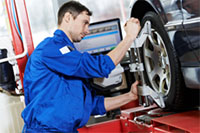Service & Support
Service & Support
Make sure you not only select the right tyres, but also regularly maintain them to ensure they perform at their best. |
A storeroom for tires should be cool, dry and dark and should be well ventilated. Storage temperature must not exceed normal room temperature. In heated rooms the tires must be shielded from the heat source.
The tires must be protected from direct sunlight and continuous changes of air. As ozone is particularly damaging, storerooms must not contain any devices that generate ozone. Solvents, fuels, lubricants, and chemicals should not be kept in tire storerooms or come into contact with tires. Ensure that tires are not stored under pressure to avoid cracks. Minimizing storage time helps avoid damage. |
Storage
Storage
Do you have any tips for storing tires?
If stored in unfavorable conditions, or if not properly handled, tires change their physical properties.
This can lead to a shorter service life, and the tires may even deteriorate to the extent that they become unusable.
Correctly stored and handled tires retain their properties virtually unchanged for several years.
Storage in the open air, even under a protective covering, is not permitted.
If stored in unfavorable conditions, or if not properly handled, tires change their physical properties.
This can lead to a shorter service life, and the tires may even deteriorate to the extent that they become unusable.
Correctly stored and handled tires retain their properties virtually unchanged for several years.
Storage in the open air, even under a protective covering, is not permitted.
Installation
Installation
Can I mount a tire on its wheel myself?
Do not attempt to mount tires on your own, you run the risk of seriously injuring yourself as well as the rim.
See a qualified professional with proper training and experience.
Do not attempt to mount tires on your own, you run the risk of seriously injuring yourself as well as the rim.
See a qualified professional with proper training and experience.
Usage
Usage
How is the tire tread measured?
The measured distance from the tread surface to the bottom of the main grooves away from the tread wear indicators. Usually specified in 1/32 of an inch.
The measured distance from the tread surface to the bottom of the main grooves away from the tread wear indicators. Usually specified in 1/32 of an inch.
Replacement
Replacement
Checking tires for wear
There are often early warning signs of wear problems. Watch for these early warning signs and you can prevent many wear problems that shorten tire life by thousands of miles. Here are some of the most common signs to look for: High and low areas or unusually smooth areas.
Outer edge or both outer edges wearing faster than the center of the tire. Center of the tread wearing faster than the outer edges. Signs of feathering. Inspect your tires frequently, look for any stones, pieces of glass, metal or other foreign objects that may wedge in the tread, they may eventually cause air loss.
There are often early warning signs of wear problems. Watch for these early warning signs and you can prevent many wear problems that shorten tire life by thousands of miles. Here are some of the most common signs to look for: High and low areas or unusually smooth areas.
Outer edge or both outer edges wearing faster than the center of the tire. Center of the tread wearing faster than the outer edges. Signs of feathering. Inspect your tires frequently, look for any stones, pieces of glass, metal or other foreign objects that may wedge in the tread, they may eventually cause air loss.





